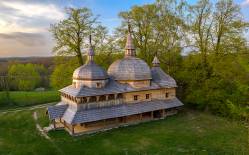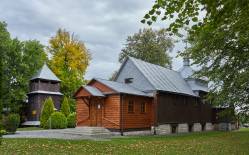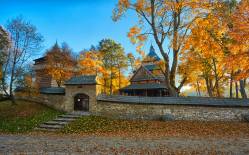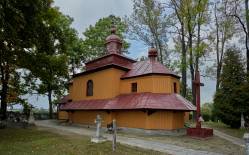The village of Opaka was established in the 1400s. The most tragic event in its history was the invasion by Tatar and Budjak hordes in 1629. Half of the buildings existing here, including the oldest tserkva, were destroyed at the time. Another church was built here probably in 1650.
The latest Greek Catholic tserkva of the Nativity of the Theotokos was built in 1756. In 1896 it was thoroughly reconstructed – the narthex and chancel, newly built at the time, inside featured false vaults, and were covered with dome-shaped roofs.
After the local Ukrainian population was forcefully resettled from here in 1947, the building was taken over by the State Treasury, and was never again used for religious celebrations.
Dating from the early history of the tserkva, a wooden base panel was a part of a gravestone presumably built in the 18th century. There is also a visible opening where once a cross was located. The opening is framed with a raised semi-circular ornament. It is likely that during a reconstruction in the late 19th century the panel was used to build a threshold at the western entrance to the church.
Unfortunately, on the night of 6 August 2003 the tserkva burnt down to the ground; the only relic is the free-standing wooden belfry.
In 2005 the belfry gate (built around 1898) was restored, which was to be followed with reconstruction of the tserkva. This however never happened. In 2010, a structure comprising the foundations and sill framing was put up at the location, to represent the original floor plan of the tserkva.
It is a noteworthy fact that in the 18th century a German colony called Fehlsendorf was established in Opaka. Later it was instituted as a separate village named Dąbków. The filial church existing here was built in 1897, to be used by the Evangelical Lutheran community. Remnants of the Evangelical cemetery from the late 19th/early 20th century can be seen at the back of the church.
Photo: Podkarpackie Regional Tourism Board
Gallery
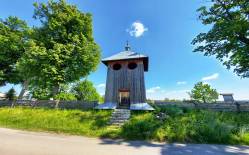
Recommended venues on the Trail



This website has been modernized with the financial support of the European Union under the Cross-Border Cooperation Programme Poland-Belarus-Ukraine 2014-2020. The responsibility for its content lies solely with the Podkarpackie Regional Tourism Board and cannot, in any case, be treated as a reflection of the position of the European Union, the Managing Authority, or the Joint Technical Secretariat of the Cross-Border Cooperation Programme Poland-Belarus-Ukraine 2014-2020.










